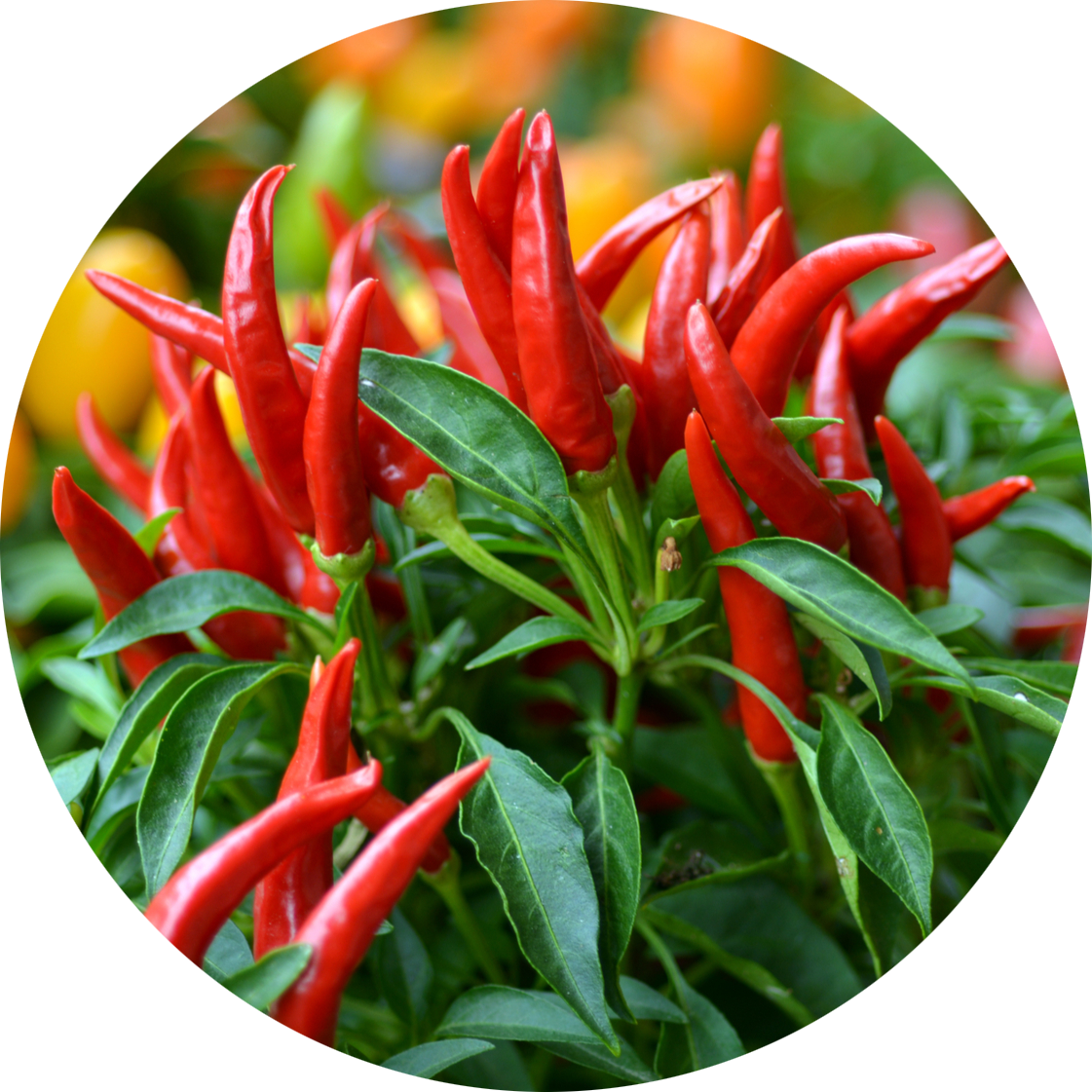(Capsicum annuum)
Today, chili pepper is an indispensable part of culinary art all over the world. It originates from a specific area which, thanks to archeology, can be accurately traced back to southwestern Ecuador, where its traces were found on stones used for grinding and in cooking vessels which are over 6,000 years old. This perennial shrubby plant from the Capsicum family was brought to the Old World by Columbus, although Portuguese sailors and merchants had much more to do with its spread to the rest of the world. Its spread across America depended on the arrival of European settlers whose slaves took along with them the ingredients from their kitchens to the north. The name of this small fiery fruit – chili – comes from the Aztec Nahuatl language. Written records made by the first conquerors mention that the Aztecs and Maya used it not only for food, but also as a medicine and for fumigating their houses.
What sets chili peppers apart from most foods is the painful sensation that they cause when we consume them. The feeling that our mouth is on fire, tingling, redness and tears in our eyes are all caused by an ingredient in chili called capsaicin. The question that inevitably arises is – if chili pepper causes such a drastic and even painful reaction, why do we eat it at all? Capsaicin triggers a warning in our body that we have acquired through evolution that we are doing something potentially dangerous. On the other hand, common sense tells us that we will not die from a bite of chili. The excitement that we feel could be compared to a rush we experience when we play extreme sports, even though we know they could be dangerous, such as parachuting or diving, or watching horror movies, when we experience an adrenaline rush. Chili pepper gives us pain, pleasure and excitement – in short, we feel that we are fully alive. Psychologist Paul Rosin described this phenomenon as an example of “a controlled risk”.
But not every pepper is the same. The intensity of spiciness is measured by the Scoville scale, named after American pharmacist Wilbur Scoville who designed it in 1912. Thus, an ordinary bell pepper measures zero SHU (Scoville Heat Units), jalapeno pepper up to 10,000 SHU, cayenne up to 50,000, Thai chili pepper up to 100,000; the “most poisonous” pepper is habanero, whose spiciness score reaches as high as 350,000 SHU.
CHILI PEPPER AND PAIN
Chili peppers use capsaicin to warn other living organisms not to destroy it. This tactic is mostly successful with mammals; birds do not have receptors that would sense the effect of capsaicin. In humans, when capsaicin comes in contact with nerve endings, it triggers the TRPV1 pain receptor that evolution has devised to prevent us from doing something that could be life-threatening, such as touching hot coals with our bare hands or drinking extremely hot beverages. TRP is an abbreviation for transient receptor potential; the mechanism of this receptor was clarified by David Julius and Ardem Patapoutian, two scientists who were awarded the Nobel Prize for Physiology or Medicine in 2021 for this discovery.
The scientific name for chili pepper, capsicum, comes from the Greek kapto, which means to swallow quickly and noisily, alluding to the burning sensation that the pepper causes. This fiery ingredient in chili pepper confirms that fire can be fought with fire – because it does not only cause pain, but can also have an impact on its reduction. What the ancient Aztecs and Maya knew thousands of years ago has been confirmed by modern medicine today: chili pepper is a powerful analgesic and circulatory stimulant: in addition to its extract being used in the famous “pepper spray” for effective self-defence, today it is often used as a component of gels, creams and patches for chronic pain.
The power of this tiny fiery plant is much greater. In the last few decades, there have been numerous clinical studies examining its effect; one of the conclusions is something that has long been suspected: regular consumption of chili peppers can prolong our life. Researchers have proved that continuous use of chili peppers in the diet is associated with a statistically significant lower rate in mortality caused by cardiovascular disorders and cancer. In fact, the effect of capsicum is much broader. In addition to analgesic and anticancer, it also has antiapoptotic, antioxidant, anti-inflammatory and neuroprotective effects, and it effectively suppresses itching and obesity.
PAIN THERAPY
In addition to providing us with longevity, capsaicin acts as a pain-killer and thus gives us a better quality of life. Numerous studies have come to the same conclusion: capsaicin from chili peppers has a huge potential in pain therapy. Thanks to its chemical structure, it shows an extremely high power of absorption when applied externally to the skin, as much as 94 per cent. Since the discovery of the TRPV1 receptors and the mechanism by which heat and mechanical stimuli are converted into electrical impulses in the nervous system, the possibilities of capsaicin have multiplied. What is important to know in pain treatment is that prolonged exposure to capsaicin is conducive to desensitisation, when the activity of TRPV1 decreases. Thus the blocking of heat receptors enables people suffering from inflammatory diseases to get rid of pain in a natural way, without aggressive analgesics that destroy the mucous membrane of the digestive system and damage the liver.
As modern research and new possibilities are constantly monitored in the Herba Svet laboratory, capsaicin has reached Comfrey Cream – Hot. In addition to chili pepper extract, it also contains extracts and essential oils of medicinal herbs, primarily comfrey, which has the power to reduce inflammation, relieve pain and stimulate tissue regeneration. This cream stimulates blood circulation in tissues, relaxes muscles, neutralises cramps and a feeling of stiffness and therefore is ideal for conditions characterised by chronic pain, such as rheumatism. If we season a dish with chili peppers, longevity and better quality of life are guaranteed!

